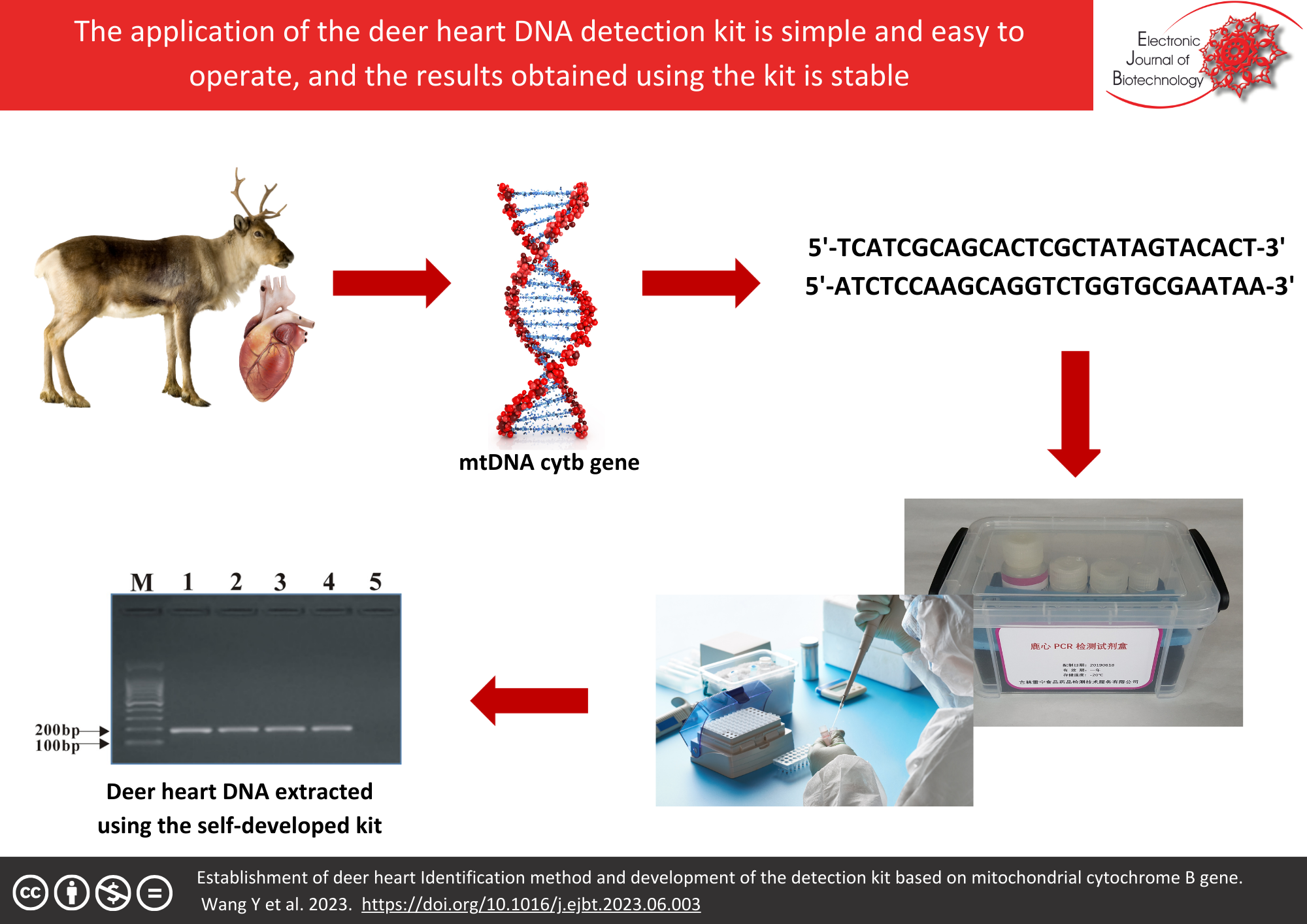Abstract
Background: Deer heart is a valuable traditional Chinese medicinal material. At present, there is no functional component or symbol component for deer heart, and it is difficult to identify them by physical and chemical methods. In this study, we established deer heart identification method based on mtDNA cytb gene, and developed a deer heart DNA detection kit.
Results: There were specific amplification bands in reference medicinal materials and true deer hearts at 194 bp, but no amplification bands in negative control and blank control. Deer heart DNA detection kit has good specificity, reproducibility and stability, and its sensitivity can reach 0.5 mg.
Conclusions: The application of the deer heart DNA detection kit is simple and easy to operate, and the results obtained using the kit is stable, which is suitable for popularization and application.
References
Guo Y, Chen D, Men Q, et al. Character and UV spectral identification of deer's heart. Journal of Chinese Medicinal Materials 1997;20(4):173-174. PMid: 12572451
Zhou Q L, Liu Y Q, Wang Y, et al. A comparison of chemical composition and bioactivity of polypeptides from velvet antlers of Cervus nippon Temminck and Cervus elaphus Linnaeus. China Journal of Chinese Materia Medica 2001;26(10):699-702. PMid: 12776321
Yang H, Wang L, Sun H, et al. Anticancer activity in vitro and biological safety evaluation in vivo of Sika deer antler protein. Journal of Food Biochemistry 2017;41(6):e12421. https://doi.org/10.1111/jfbc.12421
Yang H, Li W, Wang L, et al. The protective effects of Sika deer antler protein on cisplatin-induced nephrotoxicity. Cellular Physiology & Biochemistry 2017;43(1):395-404. https://doi.org/10.1159/000480418 PMid: 28869947
Wang R, Wang J, Sun M, et al. Molecular characterization of the Cryptosporidium cervine genotype from a sika deer (Cervus nippon Temminck) in Zhengzhou, China and literature review. Parasitology Research 2008;103(4):865-869. https://doi.org/10.1007/s00436-008-1069-2 PMid: 18575889
Yang C, Li P, Zhang X, et al. The complete mitochondrial genome of the Chinese Sika deer (Cervus nippon Temminck, 1838), and phylogenetic analysis among Cervidae, Moschidae and Bovidae. Journal of Natural History 2012;46(27-28):1747-1759. https://doi.org/10.1080/00222933.2012.693959
Kaltenbrunner M, Hochegger R, Cichna-Markl M. Sika deer (Cervus nippon)-specific real-time PCR method to detect fraudulent labelling of meat and meat products. Scientific Reports 2018;8(1):7236. https://doi.org/10.1038/s41598-018-25299-7 PMid: 29739996
Ba H, Jia B, Wang G, et al. Genome-Wide SNP discovery and analysis of genetic diversity in farmed Sika deer (Cervus nippon) in Northeast China using double-digest restriction-site associated DNA sequencing. G3 2017;7(9):3169-3176. https://doi.org/10.1534/g3.117.300082 PMid: 28751500
Hily JM, Singer SD, Villani SM, et al. Characterization of the cytochrome b (cyt b) gene from Monilinia species causing brown rot of stone and pome fruit and its significance in the development of QoI resistance. Pest Manag Sci. 2011;67(4):385-396. https://doi.org/10.1002/ps.2074 PMid: 21394871
Yanshuang W, Guangxin Y, Lihua Z, et al. Establishment of mink heart identification method based on mitochondrial cytochrome b gene and development of its detection kit. Mitochondrial DNA Part A;30(2):325-331. https://doi.org/10.1080/24701394.2018.1504932 PMid: 30318961
Li Z, Sun J, Ai J, et al. Development of Zaocys dhumnades (Cantor) DNA test kit and its application in quality inspection of commercial products. Biomedical Research 2017;28(14):6295-6299.
Yuan G, Sun J, Li H, et al. Identification of velvet antler by random amplified polymorphism DNA combined with non-gel sieving capillary electrophoresis. Mitochondrial DNA 2014;27(2):1216-1222. https://doi.org/10.3109/19401736.2014.945527 PMid: 25103424
Guha TK, Wai A, Mullineux ST, et al. The intron landscape of the mtDNA cytb gene among the Ascomycota: introns and intron-encoded open reading frames. Mitochondrial DNA Part A 2018;29(7):1015-1024. https://doi.org/10.1080/24701394.2017.1404042 PMid: 29157056
Melnikova MN, Senchukova AL, Pavlov SD. New data on MtDNA variability of pond smelt Hypomesus olidus (Osmeridae) from the Commander Islands in comparison with other populations of the species. Biology Bulletin 2018;45(1):11-17. https://doi.org/10.1134/S1062359018010089
Owa C, Poulin M, Yan L, et al. Technical adequacy of bisulfite sequencing and pyrosequencing for detection of mitochondrial DNA methylation: Sources and avoidance of false-positive detection. Plos One 2018;13(2):e0192722. https://doi.org/10.1371/journal.pone.0192722 PMid: 29420656
Mcintosh LY, Lal JE, Qin D. Usage of DNA fingerprinting technology for quality control in molecular lab bench work. Applied Immunohistochemistry & Molecular Morphology 2018;26(1):79-81. https://doi.org/10.1097/PAI.0000000000000387 PMid: 27153449
Li Y, Lu G, Liu Y, et al. Identification of three Daphne species by DNA barcoding and HPLC fingerprint analysis. Plos One 2018;13(8):e0201711. https://doi.org/10.1371/journal.pone.0201711 PMid: 30071090
El Hawary S, El Sayed A, Helmy MW, et al. DNA fingerprinting, biological and chemical investigation of certain Yucca species. Natural Product Research 2018;32(21):2617-2620. https://doi.org/10.1080/14786419.2017.1423311 PMid: 29304552
Zarini HN, Jafari H, Ramandi HD, et al. A comparative assessment of DNA fingerprinting assays of ISSR and RAPD markers for molecular diversity of Saffron and other Crocus spp. in Iran. The Nucleus 2019;62:39-50. https://doi.org/10.1007/s13237-018-0261-8
Bhakta JN, Lahiri S, Bhuiyna FA, et al. Profiling of heavy metal(loid)-resistant bacterial community structure by metagenomic-DNA fingerprinting using PCR–DGGE for monitoring and bioremediation of contaminated environment. Energy Ecology & Environment 2018;3(2):102-109. https://doi.org/10.1007/s40974-017-0079-2
Wiersma PA, Erogul D, Ali S. DNA fingerprinting of closely related cultivars of sweet cherry. Journal of the American Society for Horticultural Science 2018;143(4):282-288. https://doi.org/10.21273/JASHS04454-18
Siew GY, Ng WL, Tan SW, et al. Genetic variation and DNA fingerprinting of durian types in Malaysia using simple sequence repeat (SSR) markers. PeerJ 2018;6(9):e4266. https://doi.org/10.7717/peerj.4266 PMid: 29511604

This work is licensed under a Creative Commons Attribution 4.0 International License.
